Life Cycle of the Wasp
Vespula Vulgaris | Vespula Germanica
Hibernation and Spring Emergence of Wasps
The annual cycle of wasps begins in the spring, marking the end of their winter hibernation. As temperatures rise, queen wasps emerge from their deep slumber, having spent the winter months in a state of dormancy. During this season, active wasp nests are absent, with only queens seeking suitable locations to establish new colonies.
Contrary to a common misconception held by some pest controllers, the survival of hibernating queen wasps is not predominantly influenced by harsh winter conditions. While some queens may perish over the winter, it is often due to predation by insects like spiders rather than severe weather. Warm winters can pose a threat as queens may prematurely emerge from hibernation, leading to starvation due to insufficient food availability.
In the accompanying images, you can observe hibernating queen wasps safeguarding their wings and antennae by tucking them beneath their bodies. These appendages are crucial for the queen wasps, as wings enable their mobility, while antennae play a vital role in probing and detecting suitable nest cells before laying eggs. (Note: The white substance on the wasp is sawdust, as discovered in a wood cutting shed.)
Understanding Wasp Dietary Habits
One prevalent misconception is the belief that wasps primarily feed on insects. Contrary to this notion, adult wasps lack mouthparts designed for consuming solid foods. Instead, they possess a mouth structure similar to honey bees, featuring a set of tubes for sipping liquids, such as nectar.
It's essential to differentiate the mandibles at the front of a wasp's head from its actual mouthparts. These mandibles, resembling a crab's claw, serve the purpose of capturing and disassembling prey, which is then fed to their offspring. Additionally, mandibles are employed in wood manipulation for nest construction and play a role in inter-nest interactions involving biting and forcefulness.
Upon emerging from hibernation, queen wasps rely solely on nectar from plants and flowers as their source of sustenance, contributing to plant pollination similar to honey bees. Adult worker wasps also utilize flower nectar during the spring and early summer.
As wasp nests expand and young larvae require nourishment, adult wasps actively capture insect prey to feed the growing larvae. In return, the larvae produce a sugary liquid by regurgitating parts of the consumed insect, specifically chitin, which makes up insect exoskeletons. This sugary substance is then fed back to the adult wasps, fostering a symbiotic relationship within the nest.
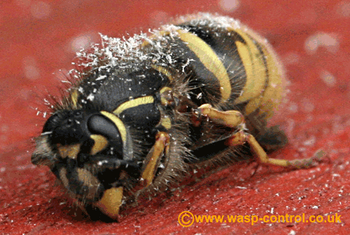
Note how she has tucked her middle legs over the top of her wings to protect them. Her hind legs are used to anchor herself in place over winter.
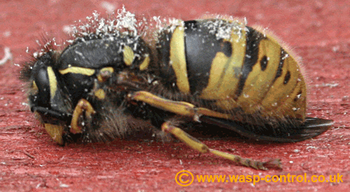
Here is another...
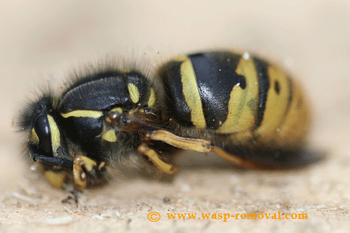
Nest Construction and Colony Development in Wasps
Following the selection of a nesting site, whether it be in a loft, shed, or ground hole, the queen embarks on the process of building a nest to initiate colony expansion. Notably, this activity involves stripping wood from various sources such as fence panels and shed walls. During the summer, you may observe faint white lines on shed walls and fences, serving as indicators of nearby wasp nest activity.
The gathered wood material undergoes a transformation through chewing, shredding, and mixing with saliva and wax. This results in a paste-like substance, which the queen utilizes in constructing the nest. The initial phase involves attaching the first part of the nest to a sturdy surface, commonly a roof rafter or another structural component in lofts and sheds.
The queen establishes a central structure known as a petiole, around which she adds cells to form the foundational structure of the nest. These cells bear resemblance to those found in beehives, although bees create their cells from wax. As the queen lays eggs in these cells, she concurrently engages in foraging for food to nourish the emerging larvae. Simultaneously, she continues building more cells during this initial stage of nest development.
The larvae experience rapid growth, fueled by the protein-rich insect food provided by the queen. This intricate process marks the beginning of colony expansion, with the queen playing a central role in both nest construction and the nurturing of the developing wasp larvae.
We have shared this video from our sister site to display how wasps strip wood.
Metamorphosis from Wasp Larvae to Adult Wasps
The transition from wasp larvae to adult wasps is a fascinating process marked by distinct stages. As depicted in the accompanying images, when the larvae reach maturity and are ready to pupate into adult wasps, they meticulously spin a silk cap over the top of their cell. Upon closer inspection, one can observe the maggot-like wasp grubs within uncapped cells, indicating that they are still in the developmental phase and continue to be nourished by adult worker wasps.
Upon reaching the appropriate stage of development, the larvae spin their caps, a process analogous to the transformation of a caterpillar into a butterfly. After a span of a few weeks, these larvae undergo a remarkable metamorphosis, emerging as adult worker wasps. Notably, the adult workers are sterile females, and while they can occasionally lay eggs like the queen, these eggs are infertile and give rise to male wasps known as drones.
With the hatching of the first brood of adult wasps, a shift in responsibilities occurs. The newly emerged adults take charge of nest-building duties and caring for the larvae. Their responsibilities extend to food collection, allowing the queen to focus solely on her role of egg laying and nest control.
As the wasp community expands in numbers, the nest undergoes proportional growth. Extensive efforts are invested in wood collection for nest building, and the brood comb expands to accommodate the burgeoning larvae. Additionally, the intricate process of water collection becomes crucial for regulating the nest's temperature. Should the nest become overheated, the resourceful wasps employ water, coupled with wing-fanning, to maintain the desired temperature within the nest. This collaborative effort showcases the sophisticated and organized nature of the wasp colony as it evolves.
How many eggs does a queen wasp lay?
While a highly efficient queen honey bee can lay approximately 2000 eggs in a single day, the egg-laying capacity of a queen wasp is considerably less prolific. A queen wasp typically lays around 100 eggs per day.
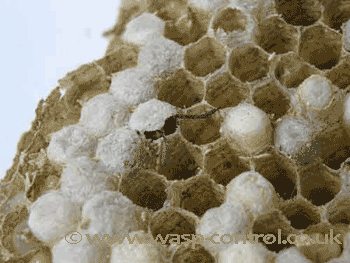
How do wasps reproduce?
Towards the end of summer or the beginning of autumn, as the nest approaches its maximum size, the queen initiates the laying of the last batch of eggs, these will become future queens and unfertilized drones. A single nest typically yields approximately 1000 to 1500 new queens.
Once these eggs are deposited, the existing queen ceases further egg-laying activities. The specialized eggs hatch, leading to the emergence of virgin queens and male drone wasps. Subsequently, they exit the nest and navigate to nearby mating areas. It is believed that drones avoid mating with queens from their own nest, relying on visual recognition to identify individuals from the same nest or colony. This behavior ensures the prevention of interbreeding and promotes an even distribution of genes.
After successful mating, the fertilized queens seek suitable locations for hibernation during the winter months, while the drones naturally reach the end of their life cycle and perish. This cyclical process ensures the continuation of the wasp life cycle with a strategic balance in genetic diversity.
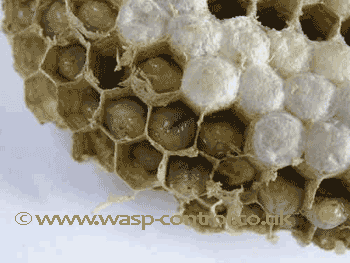
When does a wasp nest come to an end?
The conclusion of a wasp nest's life cycle begins once new queen larvae have been produced, and they've spun their silk caps in preparation for pupation. At this stage, the nest is essentially on a countdown to its demise. While the timing of new queen production varies annually, it is synchronized across nests to ensure a simultaneous emergence of enough drones and queens for successful mating.
With the completion of this reproductive phase, the adult worker wasps remaining in the nest find themselves without a food source. The absence of wasp larvae, which normally provide a sugary solution to the adults, prompts these worker wasps to venture out in search of alternative food sources, often bringing them into contact with humans. In this quest for sustenance, they are particularly attracted to areas with sugary drinks and food, such as pub gardens with pints of beer.
As autumn sets in and temperatures drop, the availability of the wasps' preferred food sources diminishes. The adult wasps left in the nest, along with the original aging queen, succumb to starvation, leading to their eventual demise. By winter, most average-sized nests have perished, although larger nests may persist longer if sufficient food is still accessible. This natural lifecycle ensures that the wasp population is regulated and contributes to the seasonal decline of nests.


